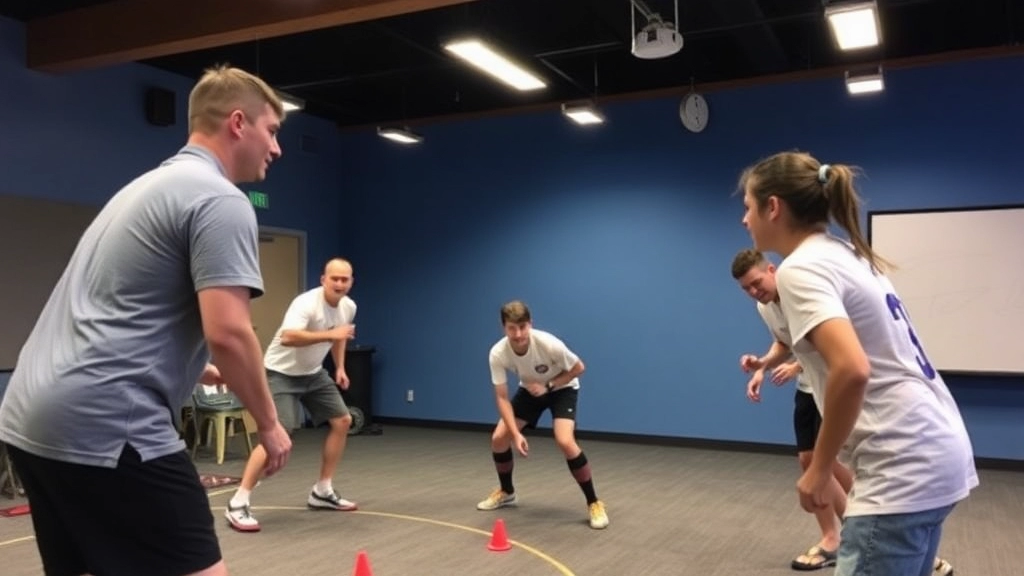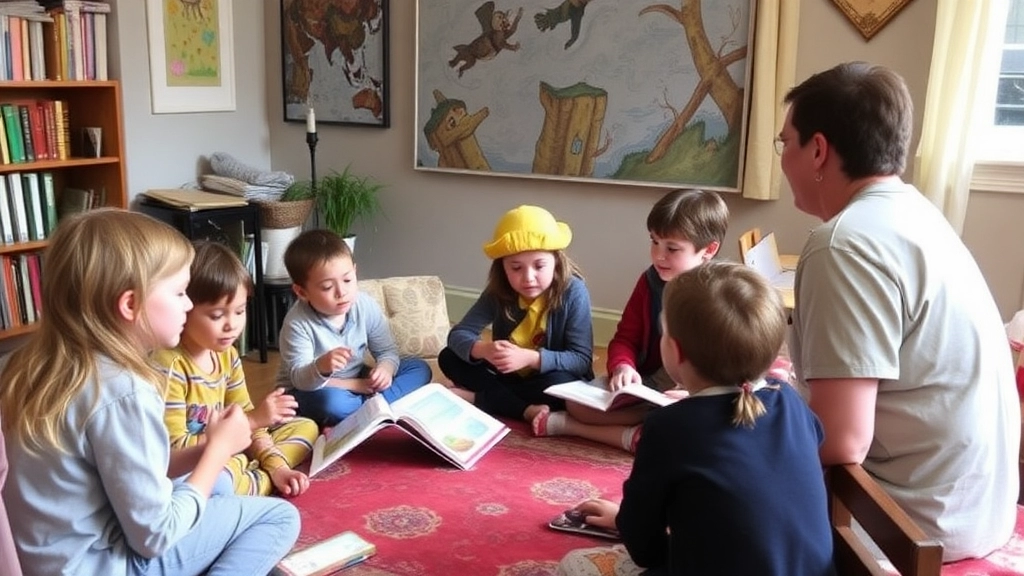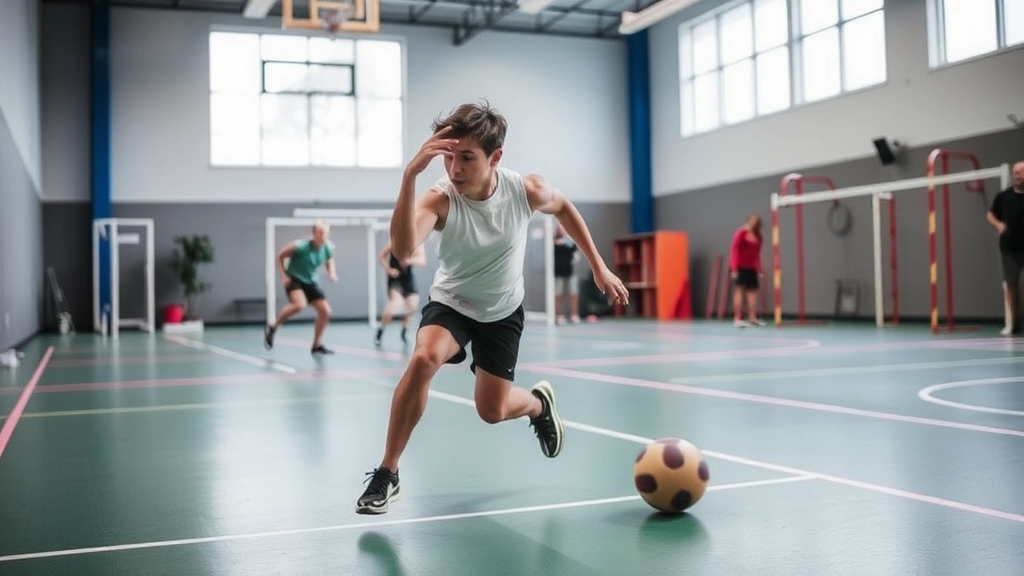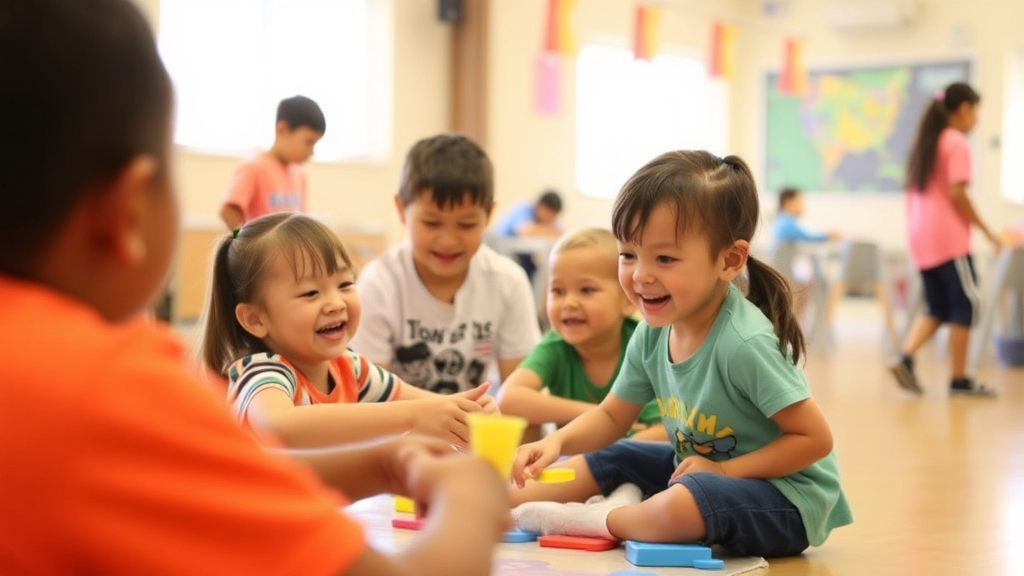Unforgettable Summer Camp Indoor Activities
Are you looking to make your summer camp unforgettable, even when the weather forces everyone indoors? Dive into our comprehensive guide on summer camp indoor activities. From creative arts and crafts to engaging educational workshops, we’ve got a plethora of ideas to keep everyone entertained and learning. Whether it’s boosting creativity through arts and crafts or fostering teamwork with indoor games, there’s something for everyone.
Explore a Variety of Activities
Explore a variety of activities, including:
- Interactive storytelling sessions
- Music and dance activities
- Science experiments that spark curiosity
- Mindfulness exercises to help kids relax
- Indoor sports to keep them active
- Themed movie nights
- Culinary classes that add a unique twist to the camp experience
Transform Your Indoor Time
Ready to transform your indoor time into a fun-filled adventure? Let’s get started!
Creative Arts and Crafts Projects
Why Bother with Arts and Crafts?
Ever find yourself or your kids glued to screens all day? Yeah, me too. We all know it’s not the healthiest habit. So, let’s talk about creative arts and crafts projects. They’re not just for kids; they’re for anyone looking to break away from the digital world and do something real, something tangible.
What Are the Benefits?
Arts and crafts aren’t just a way to kill time. They come with a bunch of benefits, like:
- Boosting Creativity: You get to think outside the box and create something unique.
- Reducing Stress: Focusing on a craft project can be super calming.
- Improving Motor Skills: Great for kids and adults alike. Fine motor skills get a workout.
- Building Confidence: Completing a project gives you a sense of accomplishment.
Getting Started: What You Need
Alright, so you’re sold on the idea. But where do you start? Here’s a quick list to get you going:
- Basic Supplies: Think paper, scissors, glue, and markers.
- Specialty Items: Depending on your project, you might need paint, beads, or fabric.
- A Workspace: A clean, flat surface where you can spread out your materials and get to work.
Types of Projects
Let’s break down some popular types of creative arts and crafts projects you can dive into:
Paper Crafts
- Origami: Simple yet intricate. All you need is paper.
- Scrapbooking: Preserve memories with photos, stickers, and captions.
- Card Making: Perfect for birthdays, holidays, or just because.
Painting and Drawing
- Watercolours: Great for beginners. Easy to blend and forgiving.
- Acrylics: More advanced but offers vibrant results.
- Sketching: All you need is a pencil and paper.
Textile Crafts
- Knitting and Crocheting: Perfect for making clothes, toys, and more.
- Embroidery: Add some flair to your fabric items.
- Tie-Dye: Great for customising shirts, bags, and even socks.
Pro Tips for a Successful Project
Here are some tips to make sure your arts and crafts projects go smoothly:
- Start Simple: Don’t overwhelm yourself with a complex project right out of the gate.
- Follow Tutorials: YouTube is a goldmine for step-by-step guides.
- Experiment: Don’t be afraid to try new techniques or materials.
- Set Aside Time: Dedicate a specific time each week for your projects to make it a habit.
Real Stories
I remember the first time I tried tie-dye. I was sceptical, thinking it was just for kids. But man, was I wrong. I ended up making some of the coolest T-shirts I’ve ever owned. And the best part? I did it with my own two hands. It was a blast, and it made me realise how satisfying it is to create something from scratch.
For more ideas on how to make your summer camp experience memorable, check out our Ultimate Guide to Summer Camp Packing and Summer Camp Art Activities.
Indoor Team-Building Games

Ever feel like your team’s stuck in a rut?
Or maybe you’re just looking for a fun way to bring everyone closer together?
Indoor team-building games are your answer.
They’re not just for kids; adults can benefit big time too.
Here’s why you should care.
Why Bother with Team-Building Games?
Stronger Bonds: Games create connections. When we play, we let our guards down.
Better Communication: You’ll talk more. And not just about work stuff.
Boosted Morale: Happy team, happy life. Or something like that.
Top Picks for Indoor Team-Building Games
1. Escape Room Challenges
Ever tried to solve a puzzle under pressure? Escape rooms are perfect for that.
- Problem-solving skills? Check.
- Teamwork? Double-check.
2. Trivia Quizzes
Who doesn’t love a good quiz? Split into teams and see who knows the most random facts.
- Fun? Absolutely.
- Competitive spirit? Oh, yeah.
3. Human Knot
Sounds weird, but it’s a blast. Everyone stands in a circle, grabs hands with people across from them, and tries to untangle themselves.
- Communication? Essential.
- Laughs? Guaranteed.
4. Office Olympics
Create mini-competitions using everyday office items. Think paperclip chain races or desk chair relays.
- Creativity? Unleashed.
- Energy? Through the roof.
Real Stories from the Trenches
I once led a team that was struggling with communication.
We tried an escape room.
By the end, we were high-fiving and laughing like old mates.
It changed the vibe of our entire office.
Pro Tips for Success
Keep it Simple: Don’t overcomplicate things.
Know Your Team: Pick games everyone will enjoy.
Mix It Up: Variety keeps things fresh.
Debrief: Talk about what worked and what didn’t.
Indoor team-building games are a game-changer.
Literally.
They’re fun, effective, and a great way to bring your team closer.
So, what are you waiting for?
Give it a go.
Your team will thank you.
And hey, if you need more ideas, check out our other sections on Creative Arts and Crafts Projects or Mindfulness and Relaxation Exercises.
Trust me, you’ll find something that fits.
Ready to play?
Educational Workshops and Classes
Alright, let’s talk about Educational Workshops and Classes. Ever wondered why some workshops feel like a waste of time while others leave you pumped and ready to conquer the world? Yeah, me too. Let’s break it down and make sure you’re getting the most out of these sessions.
Why Bother with Educational Workshops?
First off, why should you even care about workshops and classes? Simple. They’re a goldmine for:
- Skill Development: Whether it’s coding, cooking, or creative writing, workshops are a fast track to learning something new.
- Networking: You’re not just learning; you’re meeting people who share your interests.
- Inspiration: Sometimes, all you need is a fresh perspective to get those creative juices flowing.
Choosing the Right Workshop
Not all workshops are created equal. Here’s how to pick one that’s worth your time:
- Relevance: Make sure it aligns with your goals. No point in attending a pottery class if you’re trying to master digital marketing.
- Instructor Credibility: Do a quick background check. Are they experienced? Do they have good reviews?
- Format: Is it hands-on or just a lecture? Choose based on your learning style.
Making the Most Out of Workshops
You’ve signed up. Now what? Here’s how to squeeze every bit of value out of it:
- Pre-Workshop Prep: Do some homework. Familiarise yourself with the basics so you’re not lost on Day 1.
- Active Participation: Ask questions, engage in discussions, and don’t be afraid to make mistakes. That’s how you learn.
- Networking: Connect with other participants. You never know when these connections might come in handy.
Real Stories, Real Impact
Let me share a quick story. A friend of mine, Sarah, was stuck in a dead-end job. She decided to take a digital marketing workshop. Fast forward six months, she’s now running her own successful online business. All it took was one workshop to change her trajectory.
Types of Workshops You Should Consider
Here’s a quick rundown of workshops that can give you a real edge:
- Tech Workshops: Learn coding, app development, or even AI. These skills are in high demand.
- Creative Workshops: From painting to creative writing, unleash your inner artist.
- Professional Development: Public speaking, leadership training, and time management.
For parents looking to engage their kids in meaningful activities, consider enrolling them in art summer camps or social sciences summer camps. These camps offer specialized workshops that can help children develop new skills while having fun.
Interactive Storytelling Sessions

Ever thought about how to keep kids engaged without just parking them in front of a screen?
Welcome to Interactive Storytelling Sessions.
I know what you’re thinking.
How is this different from just reading a book?
Well, let’s dive in.
Why Interactive Storytelling?
Kids love stories.
But just reading to them can get boring.
Interactive storytelling makes them part of the story.
It’s like turning a book into a live adventure.
How to Get Started
You don’t need to be a professional actor.
Just follow these steps:
- Choose a Story: Pick something exciting. Think fairy tales, adventures, or mysteries.
- Create Characters: Assign roles. Let the kids be the heroes, villains, or sidekicks.
- Use Props: Simple things like hats, scarves, or toys can bring the story to life.
- Encourage Participation: Ask questions. “What should the hero do next?” “How would you solve this problem?”
Benefits of Interactive Storytelling
Why should you bother?
Here’s why:
- Boosts Creativity: Kids use their imagination to shape the story.
- Improves Listening Skills: They have to pay attention to follow along.
- Builds Confidence: Speaking and acting out in front of others can be a real confidence booster.
- Enhances Problem-Solving: They think on their feet to decide what happens next.
Real-Life Example
I once did a pirate-themed story with my nephew.
We turned the living room into a pirate ship.
He was the captain, and I was the first mate.
We hunted for treasure, fought off imaginary sea monsters, and had a blast.
He still talks about it.
Tips for Success
- Keep it Simple: Don’t overcomplicate. The story should be easy to follow.
- Be Flexible: Let the kids’ ideas shape the story. It’s more fun that way.
- Use Voices: Different voices for different characters make it more engaging.
- End with a Bang: Wrap up the story with an exciting or happy ending.
Music and Dance Activities
Ever wondered why music and dance activities are a hit at every gathering? Whether it’s a family get-together or a corporate event, these activities have a magical way of bringing people together. But how do you make sure everyone’s having a blast and not just standing around awkwardly? Let’s break it down.
Why Music and Dance Activities?
Music and dance activities are more than just fun. They’re stress-busters, mood-lifters, and a fantastic way to bond. But here’s the kicker: not everyone’s a natural dancer or a karaoke star. So, how do you cater to everyone?
Getting Everyone Involved
First off, let’s address the elephant in the room: the fear of looking silly. Here’s what I’ve found works like a charm:
- Start with Ice-Breakers: Simple, non-intimidating games like musical chairs or freeze dance can help everyone loosen up. Check out these activity ideas for more inspiration.
- Group Activities: Think dance-offs or group karaoke. When people are part of a team, they’re less likely to feel self-conscious.
- Themed Nights: A 70s disco night or a Bollywood bash can make things more exciting and give people a reason to dress up and get into character. For more themed ideas, explore our creative themes.
Practical Tips
Now, let’s get into the nitty-gritty. You want your music and dance activities to be a hit, right? Here are some practical tips:
- Playlist Planning: Create a playlist that caters to all age groups and musical tastes. A mix of classics and current hits usually does the trick.
- Dance Tutorials: For those who claim they have two left feet, short dance tutorials can be a game-changer. Think simple steps that everyone can follow.
- Interactive Elements: Incorporate props like glow sticks, hats, or even a photo booth. These little touches can make the experience more memorable.
Real-Life Example
I remember this one event where we had a silent disco. If you haven’t tried it, you’re missing out. Everyone gets headphones with different channels. You can switch between genres, and it’s hilarious to watch people dance to different beats. It’s a fantastic way to cater to varied musical tastes without blasting the speakers.
Benefits Beyond Fun
Music and dance activities aren’t just about having a good time. They offer a slew of benefits:
Science and Discovery Experiments

Ever wondered how to keep kids entertained while sneaking in some learning?
Science and discovery experiments are the answer.
They’re fun, hands-on, and pack a punch with educational value.
Why Science Experiments?
Kids are naturally curious.
They love asking “why” and “how.”
Science experiments tap into this curiosity.
They make learning exciting.
Easy Experiments to Try at Home
- Volcano Eruption
- Baking soda
- Vinegar
- Food colouring
Mix them up and watch the magic happen.
- Invisible Ink
- Lemon juice
- Cotton swab
- Paper
Write a secret message and reveal it with heat.
- Static Electricity
- Balloon
- Hair
Rub the balloon on your hair and watch it stick to walls.
Why These Work
- Engaging: Kids get to see immediate results.
- Educational: They learn basic scientific principles.
- Interactive: They get to participate, not just watch.
Pro Tips for Parents
- Safety First: Always supervise.
- Keep It Simple: Use everyday items.
- Explain the Science: Break it down in simple terms.
Real-Life Example
Remember that time you mixed baking soda and vinegar as a kid?
That was chemistry in action.
Now, you can share that excitement with your own children.
Linking It All Together
These experiments are more than just fun.
They build problem-solving skills.
They encourage critical thinking.
And they make science less intimidating.
Mindfulness and Relaxation Exercises
Ever feel like you’re constantly running on fumes? Let’s be real, life’s a whirlwind, and sometimes we just need to hit the pause button. That’s where mindfulness and relaxation exercises come in. These techniques aren’t just for monks on mountaintops; they’re for anyone looking to take a breather and reset. Trust me, I’ve been there, and these exercises can be a game-changer.
Why Mindfulness Matters
First off, why should you care about mindfulness? Here’s the deal:
- Stress Relief: It helps you manage stress better.
- Focus: Boosts your concentration and productivity.
- Emotional Balance: Keeps your emotions in check.
Think of mindfulness as a mental workout. Just like you wouldn’t skip leg day at the gym, don’t skip your mental fitness routine.
Simple Mindfulness Exercises
You don’t need a yoga mat or a quiet room. You can do these anywhere, anytime:
- Deep Breathing: Inhale deeply through your nose, hold for a few seconds, and exhale slowly through your mouth. Repeat 5-10 times.
- Body Scan: Close your eyes and mentally scan your body from head to toe. Notice any tension and consciously relax those areas.
- Mindful Eating: Focus on the taste, texture, and smell of your food. Eat slowly and savour each bite.
Guided Meditation
If you’re new to this, guided meditation apps can be super helpful. Here are a few I’ve tried and loved:
- Headspace: Great for beginners.
- Calm: Perfect for sleep and relaxation.
- Insight Timer: Offers a variety of meditation styles.
Incorporating Relaxation into Your Routine
Making time for relaxation doesn’t mean you have to block out hours of your day. Here’s how you can fit it in:
- Morning Routine: Start your day with a 5-minute meditation.
- Work Breaks: Take a 2-minute breathing break every hour.
- Evening Wind-Down: Spend 10 minutes doing a body scan before bed.
Real Talk: My Experience
I used to think mindfulness was a bit woo-woo until I tried it. During a particularly stressful project, I started doing 5-minute breathing exercises daily. It didn’t solve all my problems, but it made them a lot easier to handle. It’s like having a mental toolkit you can whip out whenever things get tough.
Linking it All Together
Mindfulness doesn’t just stand alone; it complements other activities. Pair it with:
Indoor Sports and Physical Challenges

Ever feel like your kids are bouncing off the walls on a rainy day?
Or maybe you’re just looking for a way to keep them active without the hassle of going outside?
Indoor sports and physical challenges might be your answer.
Let’s dive in.
Why Indoor Sports Matter
Keeping kids active indoors isn’t just about burning off energy.
It’s about:
- Building teamwork skills
- Improving coordination
- Boosting mental health
But how do you make it fun and engaging?
Setting Up Your Space
First things first, you need a safe space.
Clear out the living room or use a basement.
Make sure there’s enough room to move around without breaking anything.
Fun Indoor Sports Ideas
Here are some easy-to-set-up activities:
- Mini Obstacle Course
- Use cushions, chairs, and tables.
- Create a path for kids to crawl under, jump over, and weave through.
- Balloon Volleyball
- Use a string as the net.
- Balloons make it safe and fun.
- Indoor Bowling
- Use empty water bottles as pins.
- A soft ball works perfectly.
- Dance Party
- Crank up the music.
- Let them freestyle or follow a dance video.
Physical Challenges to Spice Things Up
Sometimes, a little competition can make things more exciting.
Try these challenges:
- Timed Races
- Who can complete the obstacle course the fastest?
- Balance Challenges
- Who can stand on one leg the longest?
- Strength Tests
- How many push-ups can they do in a minute?
Making It a Routine
Consistency is key.
Try to set aside time each day or week for these activities.
It keeps kids looking forward to it and makes it part of their routine.
The Benefits
Kids aren’t just having fun.
They’re:
- Building strength and stamina
- Learning new skills
- Developing a love for physical activity
Real-Life Example
I remember setting up a mini obstacle course for my niece and nephew.
They had a blast.
And the best part?
They were exhausted by the end of it.
No more bouncing off the walls.
Wrapping It Up
Indoor sports and physical challenges can be a game-changer.
They keep kids active, engaged, and happy.
So next time you’re stuck indoors, give it a try.
You might be surprised at how much fun everyone has.
And hey, it’s a great way to keep the energy levels in check.
Ready to set up an indoor sports day?
Let’s get moving!
Themed Movie and Theatre Experiences: Bringing Stories to Life
Ever wondered how to make movie nights more exciting? Or how to transform a simple play into an unforgettable experience? Themed movie and theatre experiences might just be the answer. Let’s dive into how you can elevate these events from ordinary to extraordinary.
Why Themed Experiences?
We all love a good film or play, but sometimes it feels like something’s missing. Themed experiences add that extra layer of fun and engagement. Imagine watching a Harry Potter movie while sipping on butterbeer or attending a Shakespeare play dressed in Elizabethan attire. It’s about creating memories, not just watching a story unfold.
Common Concerns
- How do I start?
- Begin with a theme that excites you and your audience.
- Think about the setting, costumes, and even the snacks.
- Is it expensive?
- Not necessarily. Many props and costumes can be DIY.
- Use what you have at home or borrow from friends.
- Will people participate?
- Absolutely! When you bring enthusiasm, others will follow.
- Encourage participation with small incentives or prizes.
Steps to Create a Themed Experience
- Choose Your Theme
- Pick a movie or play that resonates with your audience.
- Consider popular genres like fantasy, sci-fi, or classic literature.
- Plan the Atmosphere
- Decorate the space to match the theme.
- Use lighting, music, and visuals to set the mood.
- Engage the Senses
- Create themed snacks and drinks.
- Use scents or sounds relevant to the theme.
- Interactive Elements
- Host trivia or games related to the movie or play.
- Encourage guests to dress up and get into character.
- Feedback and Improvement
- Ask attendees what they enjoyed and what could be better.
- Use this feedback to enhance future events.
Real-Life Example
I once hosted a “Pirates of the Caribbean” night. We transformed the living room into a pirate ship with makeshift sails and ropes. Everyone came dressed as pirates, and we served rum (okay, it was just cola) and fish and chips. The night was filled with laughter, and it became a cherished memory for all involved.
Benefits of Themed Experiences
- Enhanced Engagement: People are more involved when they’re part of the story.
- Social Interaction: Encourages conversation and connection.
- Memorable Moments: Creates lasting memories beyond the screen or stage.
For more inspiration on creating memorable events, check out our top summer camp musicals and explore different creative summer camp themes to keep the fun going!
Culinary and Cooking Classes
Ever wondered why your pasta always sticks together? Or why your cakes never rise?
You’re not alone.
Cooking can be tricky, but it doesn’t have to be.
I’ve got some tips to make it easier.
Why Culinary Classes?
Cooking classes aren’t just for wannabe chefs.
They’re for anyone who wants to:
- Eat healthier
- Impress friends and family
- Save money by cooking at home
What You’ll Learn
In these classes, you’ll pick up:
- Basic knife skills
- How to make a perfect sauce
- Baking techniques that actually work
Hands-On Experience
You’ll get to try everything yourself.
No more watching someone else do it.
You’ll be rolling dough, chopping veggies, and sautéing like a pro.
Real-Life Examples
Remember that time you tried to make a soufflé and it flopped?
We’ve all been there.
In these classes, you’ll learn why it happened and how to fix it.
Cooking Together
Cooking with others makes it more fun.
You’ll share tips, laugh at mistakes, and celebrate successes.
Explore how summer camp activities can also enhance your cooking skills in a fun environment.
Healthier Choices
Want to eat better?
Cooking at home means you control what goes into your meals.
You’ll learn to use fresh ingredients and avoid processed junk.
Check out our guide on healthy snacks for inspiration.
Saving Money
Eating out is expensive.
Cooking at home can save you a ton of cash.
You’ll learn to make restaurant-quality meals for a fraction of the price.
Interactive Learning
These classes are interactive.
You’ll ask questions, get feedback, and improve your skills.
FAQs on Summer Camp Indoor Activities
What are some effective indoor team-building games for summer camps?
Some effective indoor team-building games include:
- Escape Room Challenges: Great for problem-solving and teamwork.
- Trivia Quizzes: Fun and competitive.
- Human Knot: Excellent for communication and laughs.
- Office Olympics: Encourages creativity and energy.
Why should I consider interactive storytelling sessions for kids?
Interactive storytelling sessions are beneficial because they:
- Boost Creativity: Kids use their imagination to shape the story.
- Improve Listening Skills: They have to pay attention to follow along.
- Build Confidence: Speaking and acting out in front of others can be a real confidence booster.
- Enhance Problem-Solving: They think on their feet to decide what happens next.
What are some easy science and discovery experiments I can try at home?
Here are some simple experiments:
- Volcano Eruption: Combine baking soda, vinegar, and food coloring.
- Invisible Ink: Use lemon juice and reveal the message with heat.
- Static Electricity: Rub a balloon on your hair and watch it stick to walls.
How do indoor sports and physical challenges benefit kids?
Indoor sports and physical challenges help by:
- Building teamwork skills
- Improving coordination
- Boosting mental health
What are some fun indoor sports ideas for kids?
Some fun indoor sports ideas include:
- Mini Obstacle Course: Use cushions, chairs, and tables.
- Balloon Volleyball: Use a string as the net and balloons for the ball.
- Indoor Bowling: Use empty water bottles as pins and a soft ball.
- Dance Party: Crank up the music and let them freestyle or follow a dance video.
How can I make interactive storytelling sessions more engaging?
To make interactive storytelling sessions more engaging:
- Choose an exciting story: Think fairy tales, adventures, or mysteries.
- Create characters: Assign roles to the kids.
- Use props: Simple items like hats, scarves, or toys can bring the story to life.
- Encourage participation: Ask questions and let the kids decide what happens next.
What should I keep in mind when conducting science experiments with kids?
Here are some tips:
- Safety First: Always supervise.
- Keep It Simple: Use everyday items.
- Explain the Science: Break it down in simple terms.
How can I set up a space for indoor sports and physical challenges?
To set up a space:
- Clear out the living room or use a basement: Ensure there’s enough room to move around.
- Make it safe: Remove any breakable items.
What are some physical challenges that can be done indoors?
Some physical challenges include:
- Timed Races: Who can complete the obstacle course the fastest?
- Balance Challenges: Who can stand on one leg the longest?
- Strength Tests: How many push-ups can they do in a minute?
How can I ensure the success of indoor team-building games?
To ensure success:
- Keep it Simple: Don’t overcomplicate things.
- Know Your Team: Pick games everyone will enjoy.
- Mix It Up: Variety keeps things fresh.
- Debrief: Talk about what worked and what didn’t.
References
-
Indoor Team-Building Games: Activities That Work
-
Interactive Storytelling: Techniques for Engagement
-
10 Easy Science Experiments for Kids

